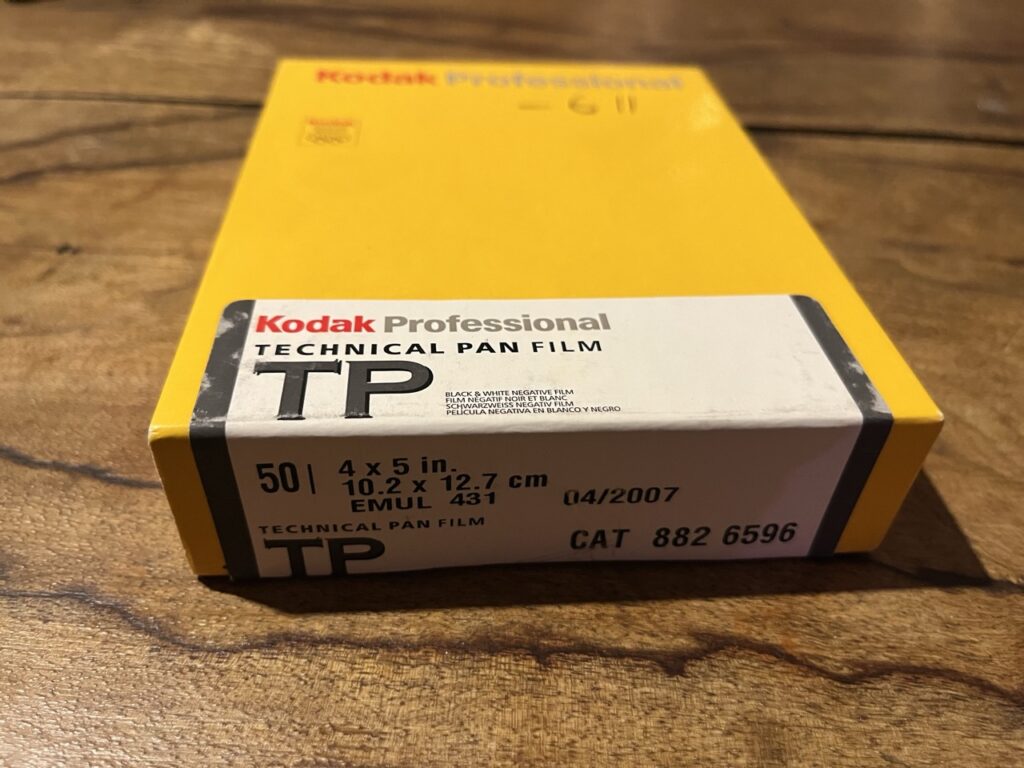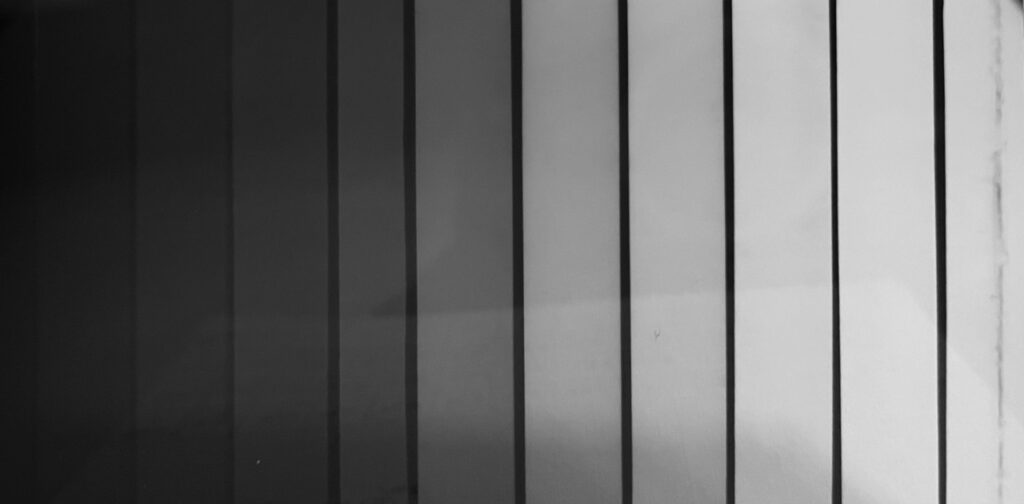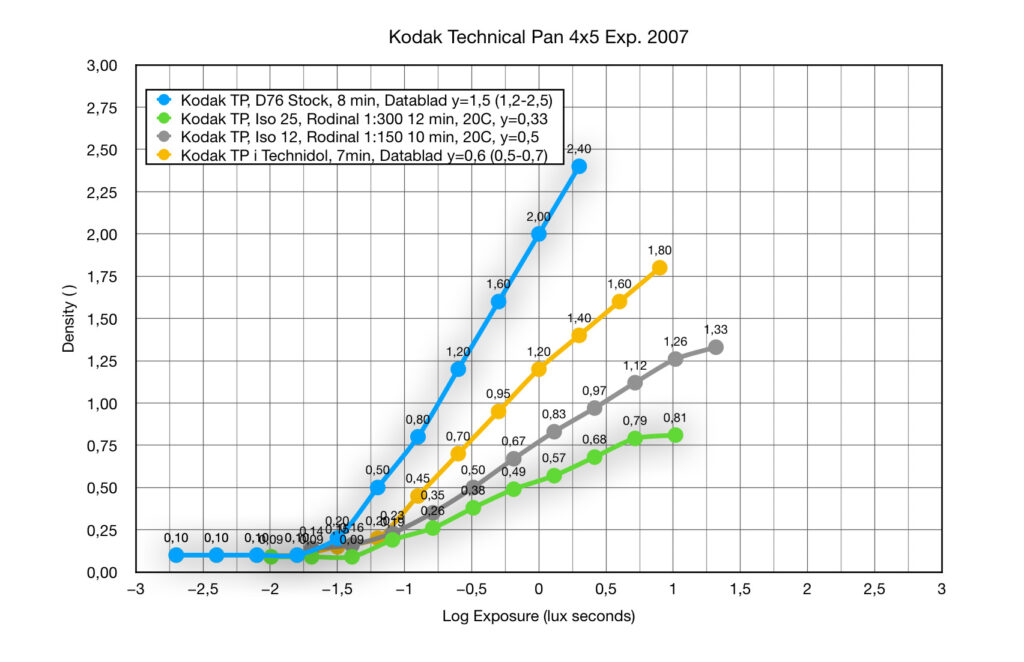In this blog I will describe my approach to find the correct exposure and sensitometry curve of expired film. If you purchase expired film e.g. Kodak Technical Pan. You never know what you get, or better expressed, you do not know how the film was stored and how deoritated the film substrate has become. In my experience I have got film which worked out very well, but also film which was totally useless with very much fogging. So it makes defnitly sense to test the first negative in a controlled environment to prevent dissapointment when taking real photos. In general all analoge film deoritate more or less when it is exposed to heat, higher humidity and x-ray.
Kodak Technical Pan 4×5’’
I was very lucky in ebay when I purchased the box of Kodak Technical Pan 4×5’’ as this films availability is not very good any longer. The box shows that the film expiered 2007 which makes it 26 years old. Outstanding was the unbelieable purchase price of 35 Euro for 44 negatives, so I did not expect that the film was stored in a cold and dry environment and the seller did not state anything about it… a typical 50:50 I would say.

Here you can find the official datasheet of Technical Pan, it is one of the slowest and finest-grained black-and-white film for pictorial photography. But for pictorial photography it needs to be developed in low contrast developer Technidol, which is not available anymore. So another challange for me is to find a low contrast developer which I can use. My first choise is to use highly dilluted Rodinal, but more to that later. Further it is a variable-contrast panchromatic film with extended red sensitivity which is most noticeable in portraits, in which it suppresses blemishes. Use this film for pictorial, scientific, technical, and reversal-processing applications. It is an excellent choice for making big enlargements.
Expose Negative in Zone System
Using 4×5’’ negatives it is quite easy to expose one singel negative in eleven different step settings. The zone system midzone V is to be exposed in optimum settings for an 18% grey card. From there I go five steps in exposure up and five steps in exposure down.
For the setup I used a led ring lamp att color temperature 4000K and a Linhof Color Kardan 4×5 with a Schneider Kreuznahc Symmar 180mm lens. To meausre the optimum exposure at zone V I used a Gossen Digisky at Iso 12.5. Spotmeasurement on the 18% grey card gave 131 cd/m2 and the incident light measurement gave 2,71 kLux. So I created following exposure table:
| Zone | 0 | I | II | III | IV | V | VI | VII | VIII | IX | X |
| Ex | 8 | 4 | 2 | 1 | 1/2 | 1/4 | 1/8 | 1/15 | 1/30 | 1/60 | 1/125 |
| Ap | 5,6 | 5,6 | 5,6 | 5,6 | 5,6 | 5,6 | 5,6 | 5,6 | 5,6 | 5,6 | 5,6 |
For exposure of 11 sections on one singel negative I use 11 covering black papers strips, which are taped respectivley onto the film cut holder. The sequence is simple. Just remove one of the strips and make this exposure. After the exposure sequence was done I chose to develop the negative in Rodinal 1:150 at 20℃ for 10 minutes. See below the outcome.

Measure the Negative Density
The next step is to measure the tranparency of the negative. For this there are special measurement devices available on the market, costing a fortune. For my private research I do not have this budget and use the Gossen spot meter for that. Any even light source can work quite well. Measureing the incident light of my source directly gave 155 cd/m2. Then I placed the negative over the light source and measured again, see following table and equations I used.
Transmittance = Transmitted Light / Incident Light
Opacity = 1 / Transmittance
Density = Log (Opacity) = Log (1 / Transmittance)
| Zone | 0 | I | II | III | IV | V | VI | VII | VIII | IX | X |
| Trans (cd/m2) | 7,2 | 8,4 | 11,6 | 15,4 | 21,3 | 33,5 | 61,2 | 75,9 | 90 | 105 | 107 |
| Trans (%) | 4,6 | 5,4 | 7,5 | 9,9 | 13,7 | 22,0 | 39,0 | 48,0 | 58,0 | 67,7 | 79,0 |
| Dens ( ) | 1,33 | 1,26 | 1,12 | 1,00 | 0,86 | 0,67 | 0,40 | 0,31 | 0,23 | 0,16 | 0,14 |
Sensitometry Techncial Pan
For the sensitometry curve we need the data for the x-Axis as Log Exposure and the y-Axis as Density. Latter I measured and calculated above, but how to calculate the log exposure in lux seconds? The simliest way for me is to measure the incident light in my film plane of the camera. At f=5,6 the measurement is 2,3 cd/m2 or lux. Multipling this value with the exposure time gives lux seconds. To find the log exposure just take the logarithm on base 10 of this value.
The diagram below shows two curves from the Kodak datasheed, developed in D76 and Technidol. I added two curves to compare, develped in Rodinal. For my applications a good option is Rodinal 1:150 for 10 minutes at density 12.5. Obviously the film lost 1 step sensitivity over the 26 years, but is still in very good condition for its age. The dip at the end of my created curves come due to reciprocity effect. I have not compensated for that and the exposure of 8 s needs addtional 2/3 steps of exposure. With this compensation, the curve would have been straight. In case more contrast would be needed, a Rodinal ration of 1:100 can be a good solution.
All in all I am very happy with the film and I am excited to use it in future. For now it is in my fridge and waits for its moment. Good luck with your purchases and trial of old and expired film.
